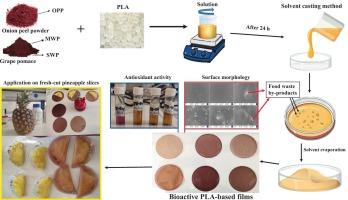Bioactive PLA-based films reinforced with agro-industrial by-products for the shelf-life evaluation of fresh-cut pineapple (Ananas comosus L.) slices
IF 8
1区 农林科学
Q1 FOOD SCIENCE & TECHNOLOGY
引用次数: 0
Abstract
This research work aimed to utilize the onion peel powder (OPP), the Merlot grape variety as winery pomace powder (MWP) and the Syrah grape variety as winery pomace powder (SWP), for the preparation of poly lactic acid (PLA)-based films in different concentrations (1 % and 2 %, w/v), and investigate if they can maintain the quality of a less studied fruit, that is fresh-cut pineapple slices (FCPS), during refrigerated storage for 12 days. PLA-based films exhibited high antioxidant and antibacterial activity, and increased mechanical and oxygen barrier properties, compared to the control PLA, while the higher concentration (2 % w/v) showed significantly (p < 0.05) better results. The addition of the powders into PLA released phenolic and flavonoid compounds. OPP1 and OPP2 had a significantly (p < 0.05) increased swelling capacity compared to MWP1, MPW2, SWP1, and SWP2. SEM analysis confirmed the incorporation of the powders in the PLA matrix. X-Ray diffraction showed that OPP1, OPP2, and MWP1 created a crystalline phase in the amorphous PLA. FTIR analysis also confirmed the presence of components owed to the added powders in the PLA matrix. The application of PLA-based films on FCPS showed that PLA/OPP1 significantly (p < 0.05) inhibited microbial growth during refrigerated storage and retained fruit quality. Treated samples showed significantly (p < 0.05) higher L*, a*, b*, and ΔE* values than the control PLA, and a different trend in weight loss, pH, total soluble solids (TSS), and total acidity (TA). Agro-industrial by-products can be a cost-effective and suitable source for the preparation of PLA-based films for fruit preservation.

农工副产物增强生物活性pla基薄膜用于鲜切菠萝片的货架期评价
本研究旨在利用洋葱皮粉(OPP)、梅洛葡萄品种作为酒渣粉(MWP)和西拉葡萄品种作为酒渣粉(SWP),制备不同浓度(1%和2%,w/v)的聚乳酸(PLA)基薄膜,并研究它们是否能在冷藏12天内保持鲜切菠萝片(FCPS)的质量。与对照PLA相比,PLA基膜具有较高的抗氧化和抗菌活性,并提高了机械和氧阻隔性能,且浓度越高(2% w/v),效果越好(p < 0.05)。将粉末加入聚乳酸中释放出酚类和类黄酮类化合物。与MWP1、MPW2、SWP1和SWP2相比,OPP1和OPP2的肿胀能力显著(p < 0.05)增加。SEM分析证实了粉末在PLA基体中的掺入。x射线衍射表明,OPP1、OPP2和MWP1在非晶PLA中形成了结晶相。FTIR分析也证实了PLA基体中存在添加粉末的成分。PLA膜在FCPS上的应用表明,PLA/OPP1显著(p < 0.05)抑制了冷藏过程中微生物的生长和水果品质的保持。处理后的样品的L*、a*、b*和ΔE*值显著高于对照PLA (p < 0.05),且失重、pH、总可溶性固形物(TSS)和总酸度(TA)的变化趋势不同。农工副产品是制备pla基水果保鲜膜的一种经济有效的原料。
本文章由计算机程序翻译,如有差异,请以英文原文为准。
求助全文
约1分钟内获得全文
求助全文
来源期刊

Food Research International
工程技术-食品科技
CiteScore
12.50
自引率
7.40%
发文量
1183
审稿时长
79 days
期刊介绍:
Food Research International serves as a rapid dissemination platform for significant and impactful research in food science, technology, engineering, and nutrition. The journal focuses on publishing novel, high-quality, and high-impact review papers, original research papers, and letters to the editors across various disciplines in the science and technology of food. Additionally, it follows a policy of publishing special issues on topical and emergent subjects in food research or related areas. Selected, peer-reviewed papers from scientific meetings, workshops, and conferences on the science, technology, and engineering of foods are also featured in special issues.
 求助内容:
求助内容: 应助结果提醒方式:
应助结果提醒方式:


